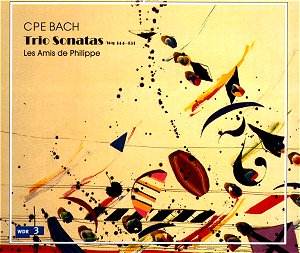Throughought
his career, Carl Philipp Emanuel Bach had to deal with the strong
influence of his father and the style of composition he represented.
Whether that influence really bothered him is not entirely clear.
In some of his vocal works, he quotes his father's music, which
doesn't look like a reaction against him. In his chamber music,
however, he clearly tries to get away from the style of his father.
Some of his trio sonatas were written in a style close to that
of Johann Sebastian. Later in his life he revised these works
in order to eschew the 'baroque' style as much as possible.
In
his notes, Andreas Friesenhagen rightly stresses that Carl Philipp
Emanuel's attempts to move away from his father's style doesn't
imply any contempt of the son for his father's works. He quotes
Carl Philipp Emanuel when he told Johann Sebastian's first biographer,
Johann Nikolaus Forkel that he and his older brother Wilhelm Friedemann
"necessarily had to choose their own kind of style because they
never would have matched their father in his style."
Carl
Philipp Emanuel Bach has attracted a lot of attention, in particular
since the commemoration of his death in 1988. But the interest
concentrates on a rather small number of works, mainly his compositions
for solo keyboard and his orchestral works. His vocal works and
a large part of his chamber music have been neglected. Of the
last category, only the flute sonatas and the three quartets for
keyboard, flute and bass are regularly played and recorded. Therefore
this recording, which is entirely devoted to the trio sonatas,
is very welcome.
The
form of the trio sonata is closely associated with the baroque
style. Basically, it is a form in which all parts are treated
equally. Here this is most clearly demonstrated in the Trio sonata
in G (Wq 144) where motifs are imitated in all three parts. But
in his trio sonatas, Carl Philipp Emanuel tried to develop his
own style as well. At the same time as he revised some early trio
sonatas (in the 1740's, when he was in Berlin) he composed some
new trios which were much more personal in style and clearly different
from his older pieces. There is hardly any polyphony left. "Instead
of imitating entries in the upper voices, we hear parallel leading
in thirds", says Andreas Friesenhagen in the liner notes. There
is a stronger influence of the style which is commonly known as
'Empfindsamkeit' - a term which is difficult to translate. In
the liner notes it is called 'sensitive style' which gives some
indication of what it means. The main feature of the 'Empfindsamkeit'
is the growing importance of the personal feelings and emotions
of the composer. That is in contrast to the baroque where composers
made use of 'topoi' - commonplaces (in the neutral sense of the
word) which don't reveal anything about the composer himself (a
good example is the ‘lamento bass’ in the adagio of the Trio sonata
in C, Wq 147).
The
performance of the ensemble 'Les Amis de Philippe' - a name which
refers to Carl Philipp Emanuel - is generally very good. The violinist
Manfredo Kraemer clearly understands the demands of the 'sensitive
style'. The support from the basso continuo is lively and imaginative
throughout. The only criticism is the playing of Manfredo Zimmermann:
he produces a beautiful sound, but I would have liked somewhat
more differentiation, both in colour and dynamics.
The
liner notes are informative, as usual in CPO productions. Unfortunately
the booklet only gives the catalogue numbers of the Wotquenne
catalogue and not the numbers in the ‘new’ Helm catalogue - therefore
I have added them.
As
I said before, some sonatas are revisions of older compositions.
Most of the originals are lost; Carl Philipp Emanuel, in a letter
in 1786, wrote that he had burnt a large number of older compositions.
But it is thought that the original of the Trio sonata in d minor
(Wq 145) is in fact the Trio sonata for 2 violins and bc in d
minor (BWV 1036), which is attributed to Johann Sebastian. I know
that CDs don’t have an educational purpose, but it would have
been very informative if this sonata had been recorded here as
well. There was enough space for it to be included. But let us
be thankful for what we have got here.
Johan
van Veen
